Tautog Fishing Master Class
A busman’s holiday with two tautog captains yields a higher education in the ways of blackfishing.

You can count on any New England charter captain to know the location and operating hours of every Dunkin’ Donuts within 10 miles of their slip. As I called Captain BJ Silvia upon my arrival in Portsmouth, Rhode Island, he directed me to the Dunks a quarter-mile from the boat (which opens at 4:30 am), along with an order Captain Rob Taylor and himself. I took seriously the job of delivering caffeination and sustenance to two of the Northeast’s most sought-after tautog fishing captains, and added an extra-large black coffee to the order to help my hookset reflex time.
While they see each other on the water many days between May and December, Silvia and Taylor rarely occupy the same cockpit. Both fill their books months ahead of the tautog fishing season so, for them, this shakedown cruise/scouting mission/busman’s holiday represented a rare opportunity for them to fish together. For me, it would be a one-day crash course in tautog fishing at the highest level.
Twenty years ago, few New England captains could fathom a fully booked tautog fishing season. Back then, the humble blackfish had only a small, cultish following of masochistic diehards willing to endure frozen fingers and stolen bait to catch a couple of these bucktoothed bottom dwellers. As tackle advanced and fishing rods got lighter and more sensitive—while maintaining strength and fish-stopping power—more anglers discovered the fun of tautog fishing. Seemingly overnight, Tautoga onitis became like a small-town band that finally caught a big break and went mainstream, leaving their fans from the old days feeling both vindicated and a little annoyed at the increased attention. The growing fishing pressure on the tog grounds has educated the fish and forced fishermen to get smarter as well.
Silvia has loved blackfish since long before they were competing with fluke for the title of the Northeast’s top bottom fish. He began tautog fishing with his grandfather and joked that he’s jealous of the young kids getting into it today. Back when he started, with monofilament and telephone-pole-stiff rods, he couldn’t feel the bites. As I swung my leg over the gunwale of Silvia’s 25-foot Parker, balancing the precious Dunkin’ payload in one hand and gripping my rods in the other, I saw just how far tog fishing has come. The rod holders were bristling with custom rods, some that looked better suited for a largemouth bass boat, and the bow was adorned with a Minn Kota Riptide Terrova Quest.
Silvia was an early adopter of saltwater trolling motors. He found the anchorless, position-holding feature to be a tautog fishing game-changer. Deploying and pulling an anchor naturally limited how many locations Silvia could hit on a trip, but the use of a spot-locking trolling motor increased the structures he could try, while simultaneously making it possible to fish smaller structures that were difficult or impossible to anchor over with any precision.
In conjunction with the side-scanning and 3D-imaging sonar, Silvia amassed a deep roster of blackfish spots to keep his clients on fish throughout the season. Taylor—whose 35-foot Terry Jason, Reel E-Z, helped drive the creation of Minn Kota’s latest and most powerful spot-locking trolling motor—the 100-inch Riptide Instinct—has done the same. On return trips from the tuna grounds throughout the summer, he keeps a close watch on his sounder for promising structure.
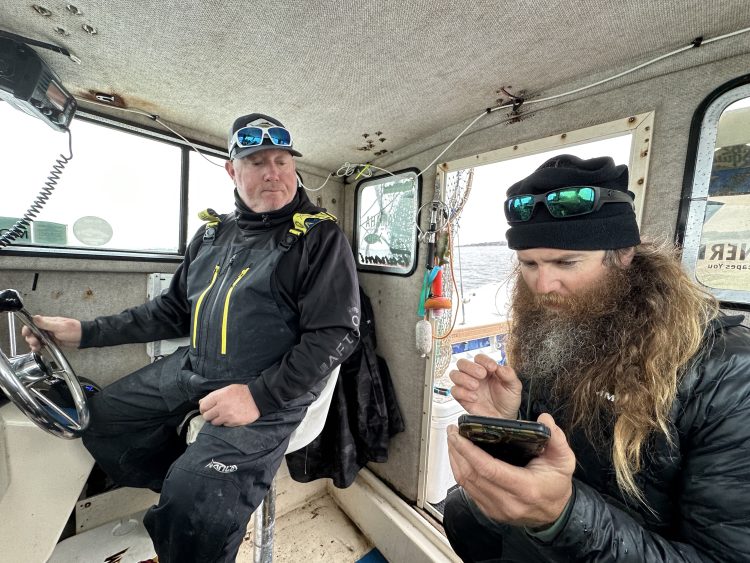
It helps that the waters from Sakonnet Point to Jamestown offer some of the richest tautog habitat in the Northeast. Even with an annually increasing number of captains running tautog fishing trips in the region, both Silvia and Taylor believe that undiscovered tog spots remain. The fish factory known as Narragansett Bay not only provides a vast spawning ground and nursery for tog, it churns out enough forage in the form of green, rock (white legger), Asian shore, and blue crabs to keep all those tog well fed.
I took a swig of the lava-hot coffee as Silvia pulled back the throttles at the first location. The next time I’d pick up the coffee cup, its contents would be ice cold. The curriculum was underway, and there was no time for distractions.
Advanced Crab Selection 302
With the Parker held fast over the structure by the electric motor, Silvia scooped a few dozen green crabs into a five-gallon bucket and placed it in the middle of the deck. He then began sifting through the bucket of writhing, clicking, seemingly identical crabs before selecting one he deemed worthy of his rig.
My crab selection has always been driven by which crabs get the quickest bites. That usually led me to the smaller, greener-colored green crabs that often triggered an immediate response. I’d failed to realize that immediate response came from the first fish that saw the crab, most often a short tog or a bergall. Silvia, I noticed, selected the larger, reddish-colored green crabs.
I assumed that color motivated his choice, but Silvia explained it was actually the hardness. The greenish-colored green crabs are a bit softer because they have molted more recently. A green crab with an orange or reddish coloration has gone longer without molting, giving it a harder shell.
But why does a harder shell make for a better bait? I love catching blue crabs for my own consumption, and I try to select those with harder, dirtier shells (known among us crabbing types as “rusty”). These crabs are heavier with meat—the hard, dirty shell indicating a long time since the crab last molted. Perhaps larger tog exhibit a similar selectiveness when it comes to green crabs.
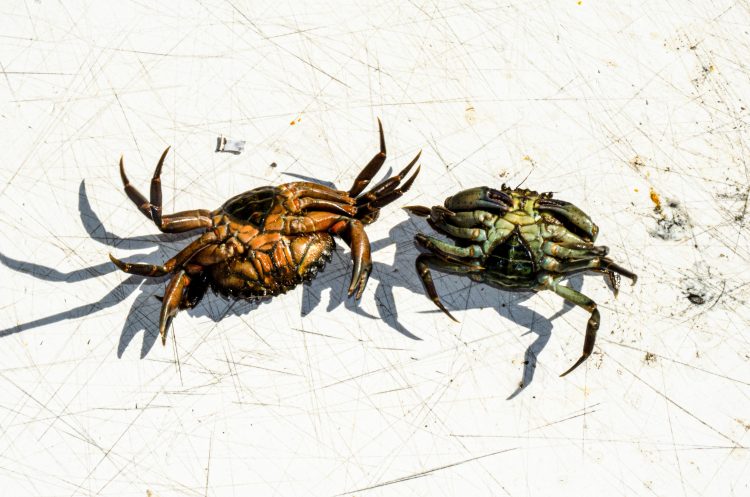
However, that would be giving them a little too much credit. Silvia explained that he preferred the harder-shelled crabs for a more practical reason: they better withstand the attacks from smaller bait stealers, giving his bait more time to attract a trophy tog.
Silvia also prefers large crabs. Bigger baits attract bigger fish, he said, but often require a longer wait for the bite, whereas a smaller crab gets instantly picked up by the first fish that sees it.
Creative Rigging 206
The night before the trip, I whipped up several tog rigs, all of the two-hook variety—a mix of V-rigs and Sliders. I knew I’d be getting a prime shot at a new personal-best blackfish and thought two hooks would improve my odds of sticking the big tog when it bit. So, I was a little surprised when I saw both Silvia and Taylor rigged up with single hooks.
Both captains favor 6/0 octopus-style hooks on single hook rigs for their togging. When targeting big tog with green crabs or smaller white-leggers—baits that a sizable tog can easily ingest—one hook is enough, they explained. They make an exception when using large white-legger crabs.
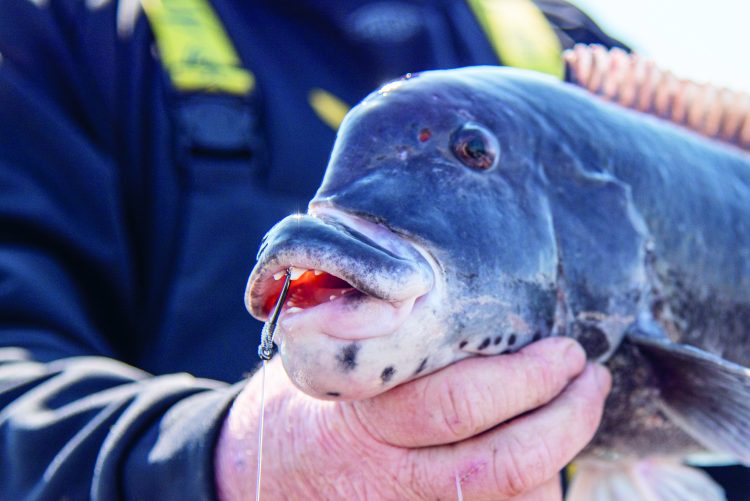
For lead, the captains rig up with flat bank sinkers. These weights lie flat on the bottom and resist rolling along the structure in the current. Subjectively, some anglers also believe this sinker style can be more easily bounced out of snags.
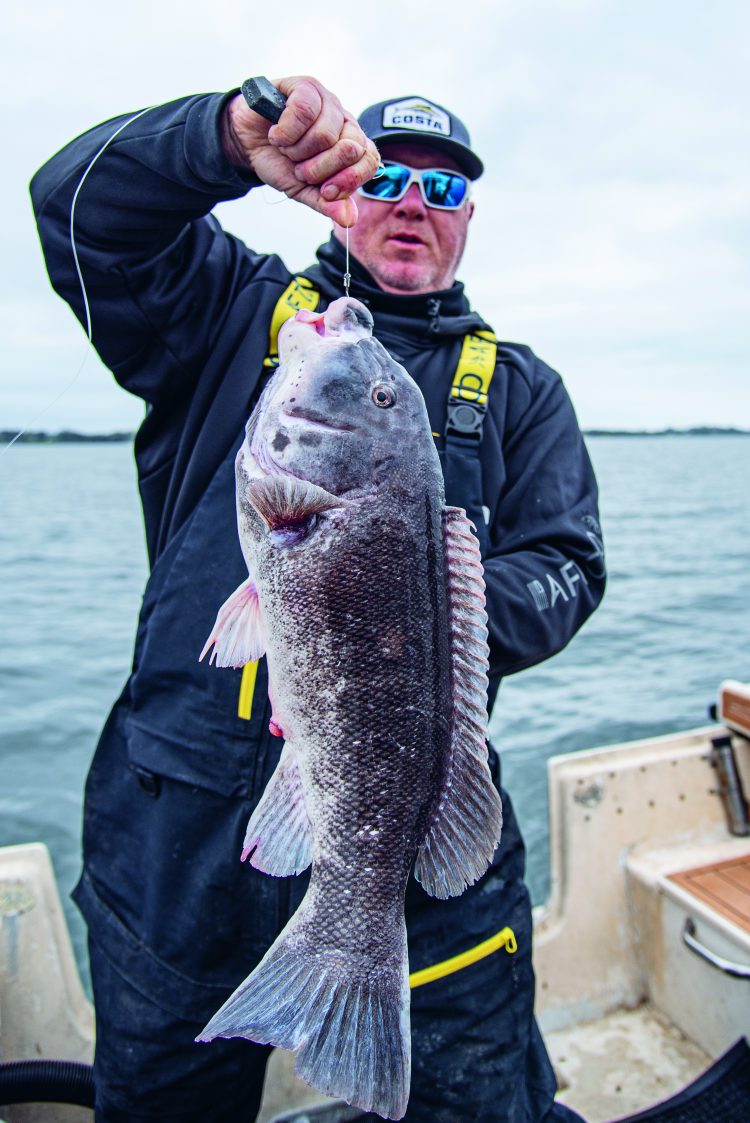
- Read More: Tautog Jigs vs. Rigs
Hook Setting 201
A secure hookset on a big blackfish begins with hook placement within the bait.
Taylor explained that tog tend to eat a crab starting at the face, so with his two-hook tog rigs, he inserts the hook in a back leg socket and out near the claws, with the points facing the front of the crab.
On single hook rigs, Silvia hooks the crab in the front leg socket, with the point coming out the back end, leaving the crab’s “apron” intact.
Experience—and many swings and misses—is the best teacher of when to set the hook on a biting blackfish. These fish bite differently on different days, with water temperature, turbidity, tide, and competition from other fish all factoring in to how aggressively, or subtly, a tog will take a crab.
Many times, when anglers miss a bite, they’re missing a smaller tog or bergall that hasn’t fully grabbed the bait. To hook a big blackfish, you must wait out the small taps, scratches, and nibbles until a larger tog muscles the smaller fish out of the way to fully engulf the bait. That hit might feel like a solid thud, a sudden weight leaning on the rig or, most exciting of all, a slack line as the tog takes the bait so aggressively that it lifts the sinker in the process.
Tidal Studies 304
In his vast roster of blackfish hot spots, Silvia has structures he likes at each stage of the tide. He factors the speed and direction of the current into where he fishes and how he orients his boat to the structure.
Throughout the morning, he continually checked his watch, waiting for slack tide, when there’d be a brief window to fish one of his favorite big-fish structures.
When the current is running hard, the place is simply too snaggy to effectively fish, even for a tog spot. But when the tide slows, the rigs fish straight up and down, and that 30-minute window often yields the biggest blackfish of the trip—as it did for me, with a personal-best-breaking 9-and-a-half pounder.

The current speed factors into the rig selection as well. Early in the morning, I had the hot hand, keeping pace with Silvia and even hooking a few more tog than Captain Rob Taylor—uncharted territory for me. Understanding that success in tautog fishing is rarely pure chance, Taylor evaluated the conditions, his rig, and his bait. After a quick adjustment, balance was restored to the togging universe.
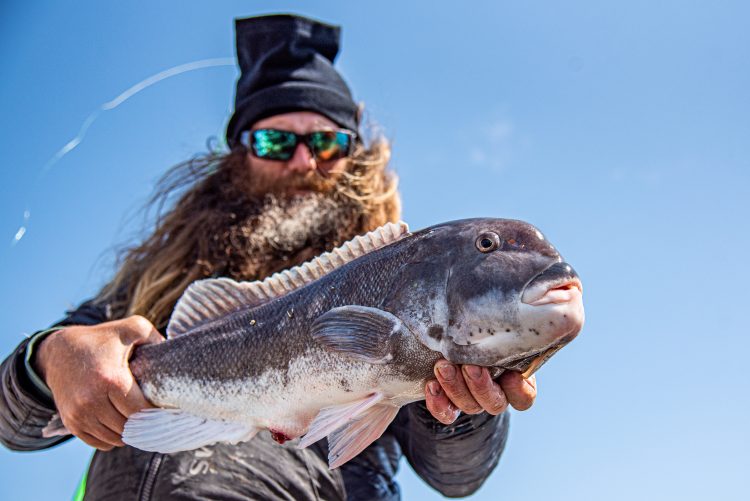
Under most circumstances, Taylor likes a longer leader to his hook. It gives the tog time to eat, and he’s used to that feel when setting the hook. But on this morning, a sluggish tide made the longer leader a disadvantage, as Taylor had difficulty feeling the bites. My two-hook V-rig, tied with a short leader, kept me in contact with the crab, which made feeling the bites and hooking the tog easier.
Clipping a couple inches off the leader put Taylor back in touch with his bait, and with that minor adjustment, he was back to catching blackfish.
We fished for over 10 hours that day, which amounted to nearly two full tide cycles and a wide range of current speeds. Throughout, Taylor regularly adjusted his rig, changing the leader length, sinker size, and number of hooks. Since I’d started out so strong, I employed a “dance with the one who brung you” strategy, sticking with the same short-leadered V-Rig despite the diminishing returns after lunch.
I could have chalked it up to a slowing bite, but Silvia and Taylor continued to hook tog on almost every drop. When I finally took the hint that a rig change was in order, Taylor laughed and said, “I was wondering when you were going to figure it out.”
The afternoon tide was considerably stronger than the morning tide, and my double-hooked crab caught the current like a sail, spinning, bobbing and weaving, probably sending any nearby tog running for the wreck in fright. Silvia’s and Taylor’s single-hook rigs with longer leaders presented the crab much more naturally. When I switched over my rig, the bites resumed immediately.
Tautog Fishing Ethics 101
Both Silvia and Taylor know how special their tog fishery is, and both work to preserve it. It can be a tough balance to strike when a charter client wants to take a 10-pound-plus fish to weigh in, but Silvia and Taylor explain how releasing the larger tog helps maintain the trophy fishery that attracted the angler to Rhode Island in the first place.
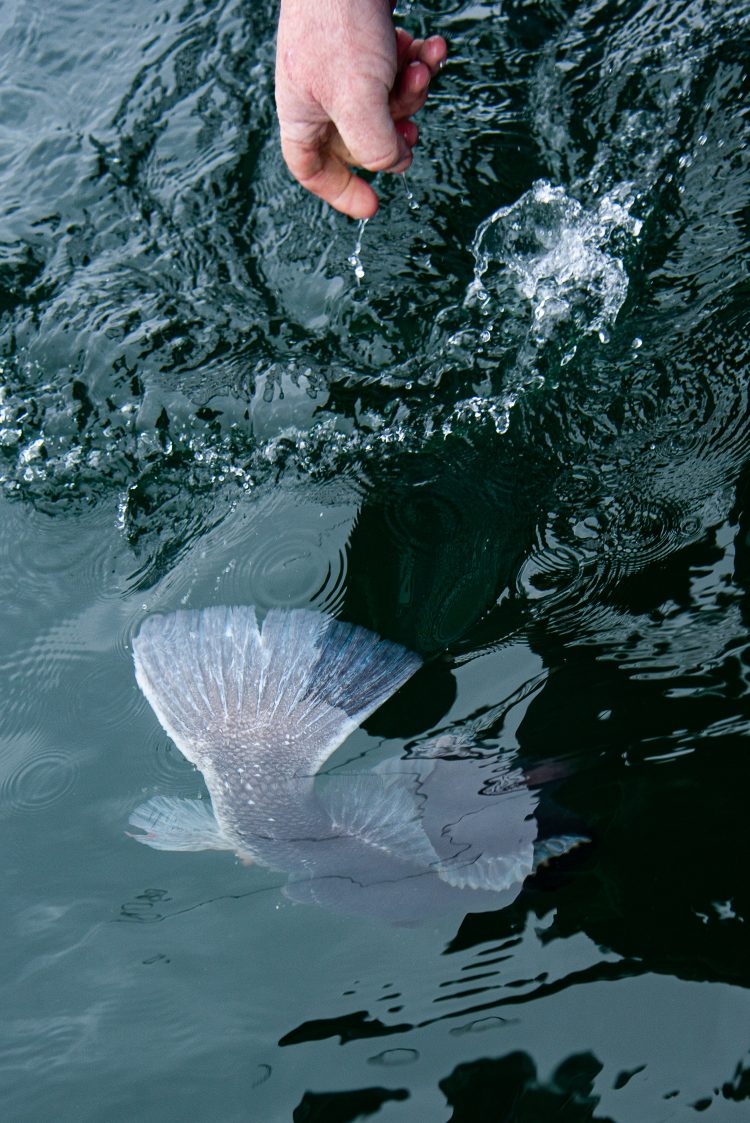
The tautog fishing professors practiced what they preached and released all of their fish on our trip. I took home a single 5-pounder, along with a cold, half-finished coffee, a new mark for my biggest-ever blackfish, and a higher education in togging that will make that 9.5-pounder short-lived as a personal best.
Take Home Notes from Professors Silvia and Taylor
- Reddish, harder-shelled green crabs survive short hits and bait-stealers long enough to attract larger tog.
- Select larger crabs and wait longer for the right bite.
- Fish single-hook rigs with longer leaders in heavy current. Use shorter leaders in small current.
- Change your rig before deciding the bite has shut off.
- Consider releasing large tog and taking only what you can eat fresh.
Book a Trip
Captain BJ Silvia
Flippin’ Out Sportfishing
401-529-2267
facebook.com/FlippinOutCharters/
Captain Rob Taylor
Newport Sportfishing Charters
978-877-0997
nsfcharters.com
Related Content
Tips for Targeting 10-Pound-Plus Tautog
1 thought on “Tautog Fishing Master Class”
-
Alex Great article, I would have to say that mastering “ Tidal studies 304 “ is the most important key to this equation, especially when fishing off of a packed out party boat. Your constantly adjusting your leader and weight set up to work with the pitch of the boat and avoiding snags from both the rock and other anglers on the boat.
Leave a Reply